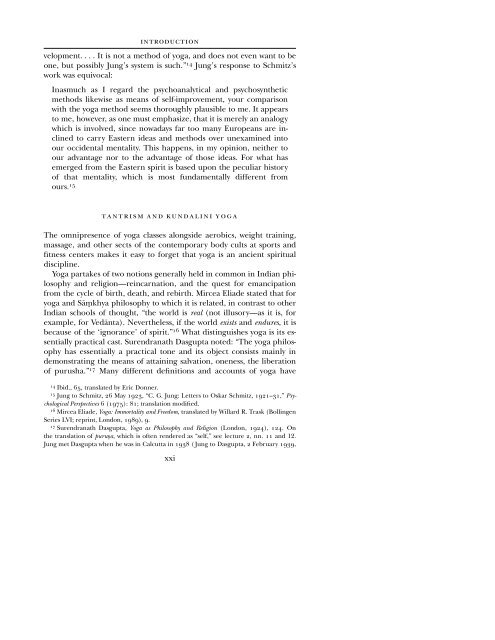CG JUNG - Countryside Anarchist
CG JUNG - Countryside Anarchist
CG JUNG - Countryside Anarchist
Create successful ePaper yourself
Turn your PDF publications into a flip-book with our unique Google optimized e-Paper software.
INTRODUCTION<br />
velopment....Itisnotamethodofyoga, and does not even want to be<br />
one, but possibly Jung’s system is such.” 14 Jung’s response to Schmitz’s<br />
work was equivocal:<br />
Inasmuch as I regard the psychoanalytical and psychosynthetic<br />
methods likewise as means of self-improvement, your comparison<br />
with the yoga method seems thoroughly plausible to me. It appears<br />
to me, however, as one must emphasize, that it is merely an analogy<br />
which is involved, since nowadays far too many Europeans are inclined<br />
to carry Eastern ideas and methods over unexamined into<br />
our occidental mentality. This happens, in my opinion, neither to<br />
our advantage nor to the advantage of those ideas. For what has<br />
emerged from the Eastern spirit is based upon the peculiar history<br />
of that mentality, which is most fundamentally different from<br />
ours. 15<br />
TANTRISM AND KUNDALINI YOGA<br />
The omnipresence of yoga classes alongside aerobics, weight training,<br />
massage, and other sects of the contemporary body cults at sports and<br />
fitness centers makes it easy to forget that yoga is an ancient spiritual<br />
discipline.<br />
Yoga partakes of two notions generally held in common in Indian philosophy<br />
and religion—reincarnation, and the quest for emancipation<br />
from the cycle of birth, death, and rebirth. Mircea Eliade stated that for<br />
yoga and Svôkhya philosophy to which it is related, in contrast to other<br />
Indian schools of thought, “the world is real (not illusory—as it is, for<br />
example, for Vedvnta). Nevertheless, if the world exists and endures, itis<br />
because of the ‘ignorance’ of spirit.” 16 What distinguishes yoga is its essentially<br />
practical cast. Surendranath Dasgupta noted: “The yoga philosophy<br />
has essentially a practical tone and its object consists mainly in<br />
demonstrating the means of attaining salvation, oneness, the liberation<br />
of purusha.” 17 Many different definitions and accounts of yoga have<br />
14 Ibid., 65, translated by Eric Donner.<br />
15 Jung to Schmitz, 26 May 1923, “C. G. Jung: Letters to Oskar Schmitz, 1921–31,” Psychological<br />
Perspectives 6 (1975): 81; translation modified.<br />
16 Mircea Eliade, Yoga: Immortality and Freedom, translated by Willard R. Trask (Bollingen<br />
Series LVI; reprint, London, 1989), 9.<br />
17 Surendranath Dasgupta, Yoga as Philosophy and Religion (London, 1924), 124. On<br />
the translation of puruüa, which is often rendered as “self,” see lecture 2, nn. 11 and 12.<br />
Jung met Dasgupta when he was in Calcutta in 1938 ( Jung to Dasgupta, 2 February 1939,<br />
xxi


